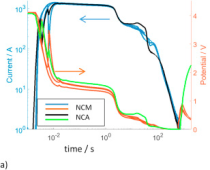One of the issues here is a lack of data from battery manufacturers (both of individual cells and packaged arrays of cells) regarding the short circuit current capability of Lithium Ion batteries.
One thing I am learning is that the short circuit current, expressed in terms of Ah capacity (e.g.10C short circuit current for a 100Ah cell/battery would mean a current of 1000A) is not all that high in many cases. Short circuit currents of 10-30C seem typical in the relatively few cases where I have found data.
For comparison, a good 8D 12V AGM lead acid battery (Lifeline 255Ah) has a short-circuit current of 7300A which corresponds to 28C. BTW, it's easy to find specs. for short circuit current for lead acid batteries.
I suspect the fact that many Li-Ion batteries do not do better is largely a function of the connection between the battery internal electrodes and the terminals. Many wound cells (cylindrical and prismatic) appear to have just a few tabs inserted into the winding, which then connect to the battery terminals. Thus all current has to flow through the relatively flimsy tabs, and within the winding it has to spiral around to get from the tabs to the ends of the winding. Compared with traditional lead-acid cell construction with all plates individually connected to the terminals, this leads to relatively high internal resistance in the metal electrodes alone (not counting the electrochemical part of the cell).
But that is not the only form of construction. For example, Tesla's new 4680 cell has a new connection approach with the whole length of the winding connected to each end of the cell, specifically to reduce internal resistance and losses in that resistance.
This suggests that Li-Ion short-circuit current may be considerably affected by construction.
I would appreciate any thoughts on this, and any data (measured or specified) on Li-Ion battery short circuit current capability.
One thing I am learning is that the short circuit current, expressed in terms of Ah capacity (e.g.10C short circuit current for a 100Ah cell/battery would mean a current of 1000A) is not all that high in many cases. Short circuit currents of 10-30C seem typical in the relatively few cases where I have found data.
For comparison, a good 8D 12V AGM lead acid battery (Lifeline 255Ah) has a short-circuit current of 7300A which corresponds to 28C. BTW, it's easy to find specs. for short circuit current for lead acid batteries.
I suspect the fact that many Li-Ion batteries do not do better is largely a function of the connection between the battery internal electrodes and the terminals. Many wound cells (cylindrical and prismatic) appear to have just a few tabs inserted into the winding, which then connect to the battery terminals. Thus all current has to flow through the relatively flimsy tabs, and within the winding it has to spiral around to get from the tabs to the ends of the winding. Compared with traditional lead-acid cell construction with all plates individually connected to the terminals, this leads to relatively high internal resistance in the metal electrodes alone (not counting the electrochemical part of the cell).
But that is not the only form of construction. For example, Tesla's new 4680 cell has a new connection approach with the whole length of the winding connected to each end of the cell, specifically to reduce internal resistance and losses in that resistance.
This suggests that Li-Ion short-circuit current may be considerably affected by construction.
I would appreciate any thoughts on this, and any data (measured or specified) on Li-Ion battery short circuit current capability.




